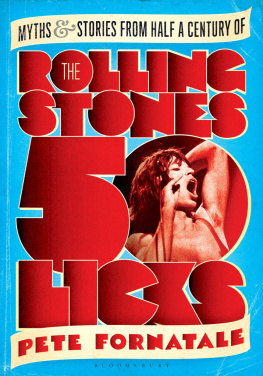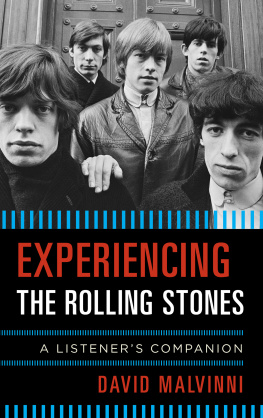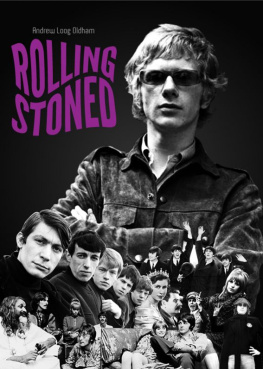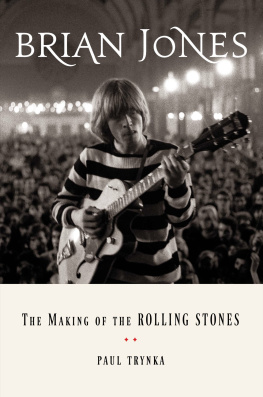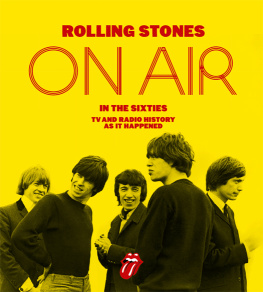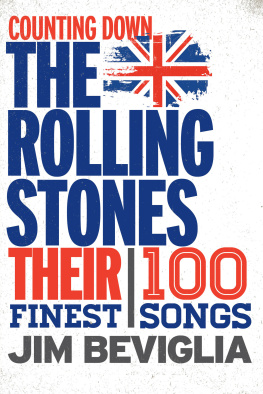
Peter Thomas Fornatale:
For my father and my daughter;
its a damn shame you never got to meet.
Bernard M. Corbett:
To my Aunt Canu. The hand-me-downs
(Aftermath, Between the Buttons,
Decembers Children) were a perfect fit.
BACK in 1977, when Love You Live came out, the question on the table for Charlie Watts was, Do you still see a real long future ahead for the Rolling Stones? His answer was as prescient as it gets:
CHARLIE WATTS: Its really funny because I just said to some guy, and he must be about twenty-four, and he said, Youve been going a long time. And I said, Yeah, but you know Duke Ellington had a band with the same personnel virtually for fifty years.
And now it has come to this: somewhere near the end of the twenty-first century, some pop cultural music superstar will be asked how long they can keep doing what theyre doing, and the answer will be, Hey, the Rolling Stones were a band with the same personnel virtually for fifty years! Fifty years. Half a century.
How ironic that rock n rollwhose imminent demise was predicted as early as the mid-1950shas produced a band whose longevity has defied all odds and given it a stature unmatched by any of its peers, including its sometimes rival/sometimes doppelgangerthe Beatles.
The first record I ever played on my debut program at WNEW-FM in July of 1969 was a Stones tune, Sing This All Together, from Their Satanic Majesties Request. I wanted something upbeat and memorable that made the case for the role progressive FM radio was playing in peoples lives at the end of the 60s. Who better than the Rolling Stones?
Fifty years ago, in the early days of the British Invasion, the Stones played devils advocate to the sainted Beatles. Their brand of rock n roll was always a bit blacker, a bit bluer than the Fab Fours, and had more of a jagged (Jaggered?) edge to it.
50 Licks will be a raucous, rollicking celebration of the rock n roll roller-coaster ride that is the Rolling Stones. We will take you on a thrilling journey Through the Past, Darkly, with all of the highest highs and lowest lows, all of the hairpin turns and screeching Steel Wheels befitting the still aptly described Greatest Rock n Roll Band in the World. Well look Between all the Buttons, put the Ya-Yas under a microscope, and, finally, place the Aftermath in historical perspective. Consider this observation by a certain Academy Awardwinning director:
MARTIN SCORSESE: For me, their music is part of my life, particularly during the 60s. Id never seen the band perform until maybe the early 70s. I experienced this music by seeing it in my head, by listening to the records... the chords, the vocals, the entire feel of their music inspired me greatly. It became a basis for most of the work Ive done in my movies, going from Mean Streets on through Raging Bull, all the way up through Casino to The Departed.
Mick and Keith were born in 1943; Charlie in 1941; and Ron, a mere pup, in 1947. So far the band has always managed to overcome any and all obstacles placed in its path, and come back bigger and stronger than ever. And there is always a ready and waiting audience for whatever it is the Stones choose to do. Amazingly, in this fickle world, they have held on to their fans from the early days, and just continue adding new ones.
There are very good reasons for this. First and foremost, there is the musica gutsy, guitar-based, blues-drenched raunch n roll that is uniquely their own. Then there is the legendary Mick Jagger personathe pouting, prancing, posturing prototype for every young vocalist who dares to dream about becoming lead singer in a rock n roll band. Finally, they are almost more defiant on the precipice of old age than they were in middle age and as young adults, albeit in different ways. They do not bow to trends or hot new acts but instead turn out worthy albums and memorable performances that remind people of exactly what it was that made them fall in love with the group in the first place.
The proof that the Stones still matter is everywhere. Contemporary artists mine their catalog for great gems to cover and record. Advertisers scramble to use memorable Stones classics to sell cars, financial services, and candy bars. And when its time to put up or shut up, the Stones routinely deliver. Mick Jaggers first appearance at the Grammys was in 2011, and it was a command performance. Right there in the Land of Gaga and the Kingdom of Bieber, Mick the Magic Jagger stole the show singing his tribute to the late Solomon BurkeEverybody Needs Somebody to Love.
We began this prologue with Charlie Wattss observation in 1977 about the potential longevity of the Rolling Stones. I wrote about it and made my own prediction in my 1986 book The Story of Rock n Roll: (Charlie) once marveled in an interview at the continuing vitality and energy of musicians from the big band era who still make relevant and vibrant music well into their sixties and seventies, often with their original bandmates. Im betting the Stones will do likewise.
And as this book will attest, the Stones keep rolling on.
EVERY GREAT STORY has to start somewhere. So where does this great story start?
July 12, 1962, was the first time that an entity publicly described as Mick Jagger and the Rolling Stones took the stage. It happened at the fabled Marquee Club in London, opening for the late, great Long John Baldry (known for a tune that went, Dont try to lay no boo-jee woo-jee on the king of rock n roll!).
Wait a minute. Mick Jagger and the Rolling Stones? In the early days, the Rolling Stones were very much Brian Joness band.
DICK TAYLOR: Brian Jones pulled Mick and Keith and then myself into the band. We were definitely Stones at that point. All the elements were there, apart from Bill Wyman, because at various rehearsals Charlie played.
Brians head must have exploded when he saw that billing, but it is explainable.
BILL WYMAN: Brian was the leader of the Rolling Stones for a year and a half. He formed the Rolling Stones.
CHARLIE WATTS: He worked very hard, Brian.
BILL WYMAN: He organized the whole thing when nobody would accept us, nobody would book us in clubs, nobody. He used to write letters to the magazines and things.
HOW LITTLE BOY BLUE AND THE BLUE BOYS BECAME THE ROLLIN STONES
DICK TAYLOR: Mick and I first met when I was eleven. Myself and another guy, Robert Beckwith, were both into rock n roll and rhythm and blues. We met Mick and we had a mutual liking of such music. When we got to be about thirteen, we were all very much into that. Eventually, we started a little band where Mick sang and Robert and I played guitar, and a guy called Allen Etherington had a little drum kit. We had a little band that didnt really have a name.
Keith knew that I was doing this band and he was too shy to ask if he could come to rehearsal. Then, he met Mick again at Dartford stationthey had known each other when they were very young. And one of them had a Chuck Berry record. They started talking and Keith came up to our next rehearsal. So we then had Keith, Mick, myself, occasionally Allen Etherington, and Robert Beckwith, and we were all playing together.
One night we all piled in Micks fathers car to watch Alexis Korner and Blues Incorporated play the Muddy Waterstype stuff. We thought we could do at least as well as that. Prior to that, we recorded stuff and we needed a name so we just decided on Little Boy Blue and the Blue Boys.
Next page
